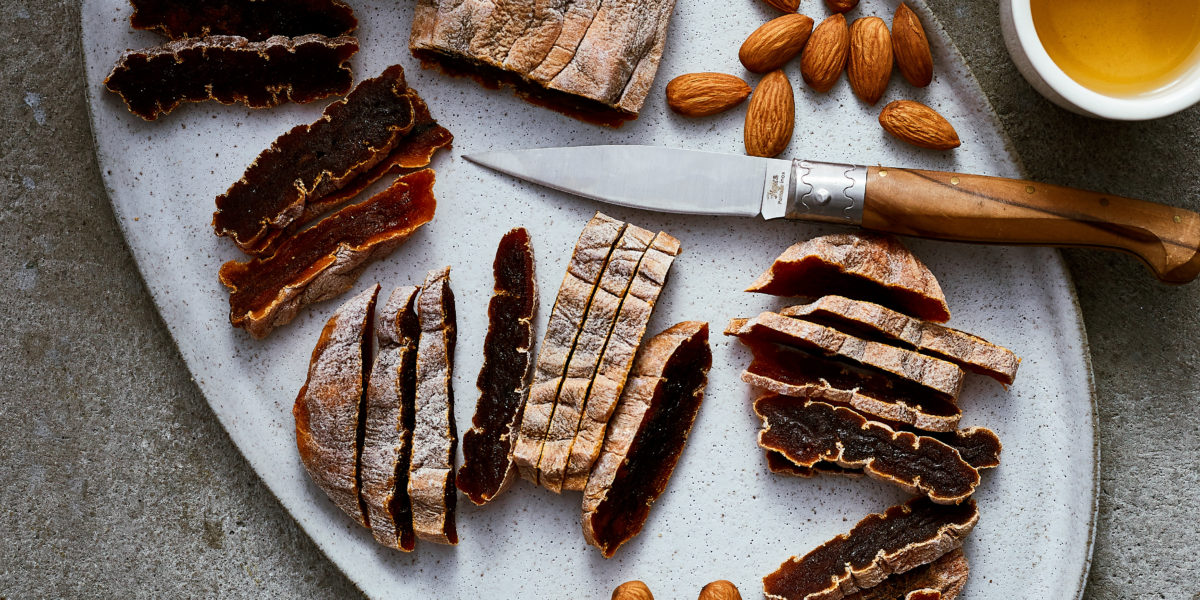
How to Make Dried Persimmons
In Northern California, a family carries on the Japanese art of hoshigaki.

In 2016, when Nicole Yamanaka moved into her grandparents’ old house in Mountain View, she and her then-fiancé, Byron, became the proud caretakers of two large Hachiya persimmon trees in the yard. Throughout Nicole’s childhood, her grandparents would pick, air-dry, and hand-massage the fruit each year to create hoshigaki, a succulent and naturally sugar-frosted Japanese delicacy often served as a snack. The technique, which goes back centuries, came to California with Japanese American farmers. Nicole, a chiropractor, and Byron, a data analyst, decided it was their turn to carry on the tradition.
The couple’s first harvest came a week before their wedding, and the just-ripened fruit needed to be processed right away. “We had more than 900 persimmons! Our friends came and helped,” says Nicole, who didn’t want to let the bounty go to waste. “I felt like Grandma and Grandpa were nearby, cheering us on.”
Today, the Yamanakas mark each October as the start of their harvest. “It’s always around baseball playoffs,” says Cyndi Sakuma, Nicole’s mom, who has seen decades of persimmon action at this house with her husband, Nolan, often with the radio or TV broadcasting strikes and runs in the background. Nicole and Byron gather the fruit, and then 10 to 15 relatives and friends come to wash, peel, and suspend the persimmons from racks in the garage. “The process is the same whether you’re drying hundreds or a few,” says Cyndi. “In Japan, everything is small. People might have one string hanging from a balcony.”
After five to eight weeks of drying and massaging (how long depends on temperature, humidity, and the size of the fruit), the persimmons shrivel until chewy but still moist. Nicole’s dad takes them back to his house to lay them flat and keep an eye on them until the natural sugar migrates from the inside outward, forming a fine white coating. Then he vacuum-seals the hoshigaki to keep and to share with loved ones as far away as Canada and Japan. The family savors the concentrated, date-and-honey flavors throughout the year, enjoying them whole or in strips, sometimes with tea.
For Nicole, the weeks of work and their sweet results are completely worth the effort. “It’s remembering our grandparents and carrying a piece of them forward,” she says. “It also tells us we did a good job. We took care of the trees, and they’re still alive.”

Alanna Hale
Japanese Dried Persimmons
These are the steps Nicole Yamanaka learned from her Japanese American grandparents, who started their family’s tradition in California.
1. Pick and wash the fruit.
Choose Hachiya persimmons (the type with a pointy base) that are mostly orange but still hard, with the stem attached. (If harvesting, try to include a bit of horizontal as well as vertical stem, then snip into a short “T.”) Rub fruit with a terry-cloth towel in a sinkful of water with a little bleach (about 1⁄2 cup for 20 gallons of water) to discourage any mold. Rinse twice and dry.
2. Trim tops and peel.
At shoulder of fruit, cut crosswise to remove top 1⁄2 in. or so, including the leafy calyx (leave stem and small ring of calyx around its base). Peel skin with a vegetable peeler.
3. Attach kitchen twine to stems and hang fruit to dry.
Tie each end of a piece of twine tightly to a persimmon stem—either around the “T” or to a straight stem—to create a balanced pair of fruits. The family drapes the pairs over a homemade PVC rack in the garage, but you could use ladder rungs or another setup. Aim a fan, set on low, at fruit during drying to improve air circulation. Let dry until persimmons are wrinkled and prunelike and form a thick outer layer, 1 to 2 weeks. Don’t worry if they get brown flecks as they start to oxidize.
4. Start massaging.
Every few days, then daily as they start to get drier, very gently massage persimmons between your palms to break up the outer layer and inner pulp until you don’t feel any lumps (though you may feel a few small seeds). Massaging releases moisture and sugar and creates an even inner texture. If any mold appears, spritz fruit with vodka (don’t dunk fruit; it will fall off the twine). Continue until fruit starts to get a sugary white coating, 4 to 6 weeks total.
5. Cure and package.
Take persimmons from racks and cut off stems, string, and round base of calyx. Set fruit flat or slightly overlapping on baking sheets. Dry indoors by a sunny window, draping with a clean kitchen towel at night, until the sugary coating forms all over the fruit, about a week. (Fruit should still be moist; don’t let it harden.) Vacuum-seal the hoshigaki, or wrap in plastic wrap, then put in resealable plastic bags. Keep at room temperature for a few months or chill or freeze up to a year.
Hoshigaki to Go
Not everyone has a Hachiya persimmon tree in their backyard to make their own hand-massaged hoshigaki. You can, however, find the treats online through Penryn Orchard Specialties.com ($55/lb). Of course, they’d work well in recipes that call for dried fruit—couscous, salads, desserts—but for an ingredient made with such handcrafted care, sometimes it’s best to enjoy the amber treasures simply, either on their own or with a cup of green tea and some roasted almonds.
Read the Current Issue Here!
Get one year of Sunset—and all kinds of bonuses—for just $24.95. Subscribe now!
